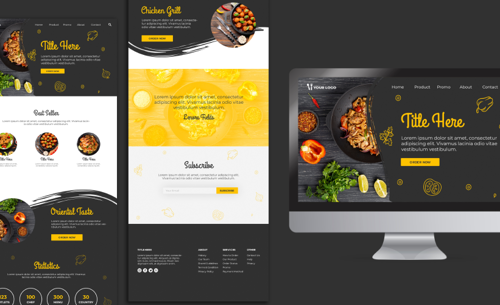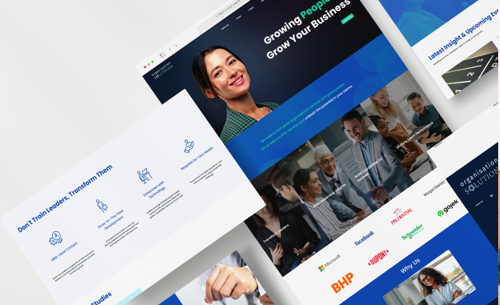- Oct 13, 2023
Understanding Website Design & Development in 2023

As businesses strive to reach success in today’s digital landscape, website design and development has become a critical factor for effectively engaging their target audience. To create an effective site that both looks great and provides users with the necessary functions, it requires careful collaboration between designers and developers - this guide will provide insight into the core components of web design, development aspects needed to produce a quality experience, as well as how important strong teamwork is when attempting such tasks.
Key Takeaways



The Core Components of
Website Design

Web developers are a vital part of the website formation process, focusing on the looks and interaction for users. They strive to construct an eye-catching design that benefits from user experience while still staying in line with brand identity. By enlisting aid from a premier web development firm, organizations can redevelop their online presence by integrating components such as structure/layout, readability & typography,color scheme plus branding into one uniform concept which engages viewers.
The key elements when making any website involve:
1. Attractiveness
The design should draw customers and represent company’s image.
2. Navigation
Layout must be easily navigable.
3. Typography
Appropriate fonts guarantee clarity between parties.
4. Color Scheme
Harmonizing colors look good together but also make sure it’s recognisable.
5. Branding
Continued congruence throughout the site helps keep solid recognition of business identity among its clientele.
6. User engagement features
Have to stay current otherwise audiences may not retain interest over long periods of time.
These all come into play when wanting to create something visually pleasing yet efficient enough where people want to interact with it at the same time. With combination above, designers can build websites that simultaneously meet visitor’s expectations as well as stand out amongst competitors.
Layout and Structure
A positive user experience is supported by a properly structured and easy-to-navigate website, making web design layout and structure fundamental. Visual elements such as colors, themes, icons or buttons are necessary for constructing an appealing interface to keep visitors engaged while exploring the site further. A dependable development company can help create a well laid out website that provides users with simple access combined with enjoyment. Digital marketing services should be considered in order to make sure your webpage operates correctly. They could aid enhance performance of the page so it meets requirements from customers appropriately. Concentrating on construction & organizing makes it possible for you not only to get aesthetically pleasing results but also develop one which works excellently too - this can ensure satisfaction both visually and operationally when using the app/website.
Typography and Readability
Developing a user friendly and visually appealing website requires appropriate typography to ensure readability. Website development services can help with selecting the right font type, size, weight and spacing while also providing guidance on contrast and colour choices. This helps make sure that visitors are able to quickly understand information presented in a logical manner for an optimal user experience. Utilizing these elements makes it possible for websites created by developers to convey messages accurately while still being attractive enough draw attention from users who may be seeking similar content elsewhere online.
Color Scheme and Branding
A qualified design company can assist you in creating an aesthetically pleasing website through the use of a complimentary colour palette and branding that reflects the brand identity to its target audience. This is done by utilizing color theory, finding an appropriate representation for your brand image, as well as enabling responsiveness on devices with different sizes. With more than half of global web traffic being mobile based this year, it’s important to have a professional development team optimize your site accordingly so users experience no difficulty navigating regardless of what device they choose to access it from, providing them consistency between platforms without disruption.
The Crucial Aspects of Website Development

Web designers focus on the appearance of a website while web developers are entrusted with creating and maintaining it technically. Website development incorporates activities like coding, scripting, as well as combining design elements and functionality. Working together with an expert website development company guarantees that your site meets all technical specifications for ideal performance and user experience.
The process of website construction revolves around three core areas: front-end & back-end engineering. Understanding programming languages such as HTML, CSS & JavaScript. Plus responsive design so you can provide top notch mobile optimization across different devices or screen sizes.
Front-End vs Back-End Development
Web development is divided into two main areas: the front end and back end, each with its own focus on website building. Front-end developers work to make sure websites are visually attractive and interactive for users, using HTML, CSS, as well as JavaScript. For back-end operations such as data management related tasks, there’s a need for expertise in languages like Java or PHP among others. Familiarity with server side frameworks Node.js, Ruby on Rails etc. is also needed here. An effective combination of these aspects from both sections makes up a successful website that meets customer requirements while being aesthetically pleasing at the same time.
Common Programming Languages
Web development relies on programming languages as the basis to develop websites with desired functionality. Commonly used programs include HTML, which is used for structuring and displaying content. CSS, responsible for styling said content. JavaScript provides interactivity to enhance user experience. Other language choices may depend upon project requirements and web developer abilities - PHP, Ruby or C# are examples of additional possibilities. Through understanding how each program works, developers create sites that look attractive but also work reliably per brand specifications requested by users in a smooth manner facilitated by these codes.
Responsive Design and Mobile Optimization
With the abundance of mobile users, website development should be prioritized to have responsive design and mobile optimization. Responsive design makes sure that websites are adjusted accordingly with different screen sizes for uniform user experience over varied platforms while mobile optimization allows a smooth performance on any handheld device. Enhanced user experience, higher accessibility rate, SEO improvements and greater conversion rates are just some advantages gained through using this method. These perks involve additional resources plus thorough testing across multiple gadgets as well as keeping up with current tech trends.
With the abundance of mobile users, website development should be prioritized to have responsive design and mobile optimization. Responsive design makes sure that websites are adjusted accordingly with different screen sizes for uniform user experience over varied platforms while mobile optimization allows a smooth performance on any handheld device. Enhanced user experience, higher accessibility rate, SEO improvements and greater conversion rates are just some advantages gained through using this method. These perks involve additional resources plus thorough testing across multiple gadgets as well as keeping up with current tech trends.
The Collaboration Between Web Designers and Developers

For a website to achieve success and meet the goals of its brand, it requires an effective collaboration between web designers and developers. Designers create visuals such as the layout, color scheme, and typography. While developers employ coding techniques to bring these designs into reality with full functionality. To ensure that their work is synchronized effectively, there must be clear communication and planning in place between them both. The roles they play need to be defined clearly so everyone involved can understand how design works with function for overall harmony across all areas of site creation. Going forward, this article explores more specifically aspects like shared understanding about respective roles or integration strategies between elements for optimal results from teamwork efforts made by web creators.
Communication and Planning
Designers and developers of a website must ensure their design elements are aligned with the project goals by having clear communication. This way, they can both comprehend each other’s responsibilities in order to create an integrated site that meets customer requirements. To do this effectively, it is essential for them to establish a plan which outlines tasks such as timelines and deliverables so there will be consistency throughout development progress. Holding regular meetings where updates can be shared helps keep everything on track while guaranteeing positive outcomes related to objectives mentioned at the beginning of said project.
Integrating Design and Functionality
For a website that is both visually pleasing and functional, close cooperation between web designers and developers needs to happen. Designers help convert ideas into an attractive look for the site while coders create the functionality of it. For this integration to be successful, they need an understanding of one another’s abilities. Designers should know about technology related matters in relation to web development, while developers must recognize the importance of decent design plus user experience. By cooperating together as well as recognizing each other’s strengths and weaknesses, a website can be created which not only looks great but also performs perfectly too – meeting goals set by brand owners plus users’ requirements alike.
Hiring a Website Design and Development Company

It is important to conduct an in-depth analysis of a website design and development company’s qualifications, pricing plans as well as packages before making any decision. Engaging the right professionals guarantees that your webpages are optimized up to high standards for maximum business value.
This article will elaborate on why assessing the expertise/experience of such agencies is critical along with explaining their various budgeting solutions so you can make informed decisions regarding which option fits within your project specifications or financial capability best.
Evaluating Expertise and Experience
Assessing the expertise and experience of a firm in web design and development can ensure they deliver an impeccable website to fulfill your specific needs. When assessing such companies, it is important to investigate their abilities with HTML, CSS, JavaScript, and other programming languages, plus graphic design skills for crafting visuals that are attractive yet practical. Understanding user experience (UX) layout will also be essential when constructing said website. Not overlooking SEO, which should give additional boosts on search engine visibility.
To evaluate these proficiency levels more effectively one could review portfolios from previous projects carried out by them while checking customer reviews along asking questions about the entire process associated with web designing & development operations - enabling you to make clear decisions whether or not this company would suffice based on what’s needed from them or otherwise look elsewhere instead.
Understanding Pricing and Packages
Comparing the different pricing packages and services available from a web design and development company can help you make an informed decision for your website project. Common offerings include basic site building, custom designs, e-commerce platforms, as well as ongoing maintenance services. Considerations should also be taken when deciding between DIY solutions or professional guidance. While self-built sites may be more affordable in terms of cost, they might not have the same quality finish compared to that of experts with years worth of experience within this industry. Professional work usually comes at higher prices but offers superior service such customer support which is certainly invaluable during any long lasting website projects without a doubt!
DIY vs Professional Website Design and Development
Choosing between DIY website design and hiring professionals can be a difficult decision. We will explore the advantages of both routes, so that you are able to make an informed choice when it comes to designing and developing your website.
DIY solutions offer cost-effectiveness as well as complete control over every step of the process. On the other hand, seeking help from specialists in web creation has its own set of benefits: ensuring quality results tailored specifically for users’ needs while providing peace of mind about all aspects involved with creating a successful page or site online. Taking into consideration one’s budget constraints, required goals for completion, and available resources should always come first before opting either route, doing by yourself or choosing professional services.
Advantages of DIY Solutions
DIY solutions can be an ideal choice for those with limited financial means, since they are usually more economical than employing a website design and development agency. To that, DIY approaches provide users greater command over the growth procedure, granting them the capacity to customise their site according to personal specifications.
Advantages of doing it yourself include accessiblity in terms of timeframe as well as cost-effectiveness when constructing websites. Plus there’s no doubt about gaining knowledge regarding web designing and developing along the way! With these options available at one’s own pace by making use of software tools too, flexibility is definite advantage. Opting out this route gives you autonomy so you have complete authority to make any changes desired on your very own webpage anytime needed.
Benefits of Hiring Professionals

Hiring professional web designers and developers is the key to having a website with excellent visual appeal as well as full functionality. Their extensive knowledge in website design and development, along with an understanding of essential aspects like core components or collaboration between designers and developers, makes them indispensable for creating top-notch websites. Engaging a development company also provides access to various services that ensure your site remains updated over time, something very beneficial for businesses needing constant maintenance on their page.
Summary
Website design and development are integral to the success of a website, enabling it to meet the needs of both its users and brand. Working in close collaboration between web designers and developers, factors such as layout/structure, typography/readability, branding via color scheme plus front-end & back-end development, programming language skills including responsive design all come into play when creating an eye catching yet functional website.